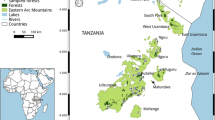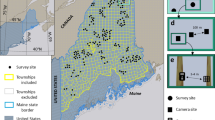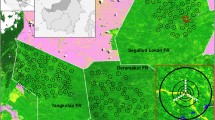Abstract
With terrestrial mammals facing worldwide declines there is an increasing need to effectively monitor populations so that appropriate conservation actions can be taken. There are many techniques available to survey terrestrial mammals and in recent years there have been a number of studies comparing the effectiveness of different methods. Most of these studies have not considered complementarity (the degree to which techniques detect unique species) and effectiveness across ecological gradients. In this study we examined three widely used techniques, camera trapping, live trapping and hair detection, for their complementarity across a vegetation and disturbance gradient. Overall, camera trapping detected more species than any other single technique, but live trapping complemented the cameras by consistently detecting unique species. Additionally, technique effectiveness differed between vegetation types; cameras alone were most effective in dry forest systems while cameras combined with live traps were most effective in wetter forest systems. These results suggest that care needs to be taken when sampling across heterogeneous landscapes because relying on one technique alone could result in certain taxa being systematically overlooked, leading to potentially erroneous conclusions.




Similar content being viewed by others
References
Ahumada JA, Silva CEF, Gajapersad K, Hallam C, Hurtado J, Martin E, McWilliam A, Mugerwa B, O’Brien T, Rovero F, Sheil D, Spironello WR, Winarni N, Andelman SJ (2011) Community structure and diversity of tropical forest mammals: data from a global camera trap network. Philos Trans R Soc Lond B 366(1578):2703–2711. doi:10.1098/rstb 2011.0115
Barea-Azcon JM, Virgos E, Ballesteros-Duperon E, Moleon M, Chirosa M (2007) Surveying carnivores at large spatial scales: a comparison of four broad-applied methods. Biodivers Conserv 16(4):1213–1230. doi:10.1007/s10531-006-9114-x
Bureau of Meteorology (2013) Climate statistics for Australian locations. http://www.bom.gov.au/climate/data/?ref=ftr. Accessed Mar 2013
Burnham KP, Anderson DR (2002) Model selection and multimodel inference: a practical information-theoretic approach. Springer, New York
Catling PC, Burt RJ, Kooyman R (1997) A comparison of techniques used in a survey of the ground-dwelling and arboreal mammals in forests in north-eastern New South Wales. Wildl Res 24(4):417–432. doi:10.1071/WR96073
Cheal D (2010) Growth stages and tolerable fire intervals for Victoria’s native vegetation datasets. Fire and adaptive management report no. 84. Department of Sustainability and Environment, East Melbourne
Claridge AW, Paull DJ, Barry SC (2010) Detection of medium-sized ground-dwelling mammals using infrared digital cameras: an alternative way forward? Aust Mammal 32(2):165–171. doi:10.1071/am09039
Cullen M (2009) Vascular plant and small mammal communities over an elevational gradient. PhD Thesis, Deakin University
De Bondi N, White JG, Stevens M, Cooke R (2010) A comparison of the effectiveness of camera trapping and live trapping for sampling terrestrial small-mammal communities. Wildl Res 37(6):456–465. doi:10.1071/wr10046
Espartosa KD, Pinotti BT, Pardini R (2011) Performance of camera trapping and track counts for surveying large mammals in rainforest remnants. Biodivers Conserv 20(12):2815–2829. doi:10.1007/s10531-011-0110-4
Garden JG, McAlpine CA, Possingham HP, Jones DN (2007) Using multiple survey methods to detect terrestrial reptiles and mammals: What are the most successful and cost-efficient combinations? Wildl Res 34(3):218–227. doi:10.1071/wr06111
Gibson LA, Wilson BA, Aberton JG (2004) Landscape characteristics associated with species richness and occurence of small native mammals inhabiting coastal heathland: a spatial modelling approach. Biol Conserv 120:75–89
Harris RL, Nicol SC (2010) The effectiveness of hair traps for surveying mammals: results of a study in sandstone caves in the Tasmanian southern midlands. Aust Mammal 32(1):62–66. doi:10.1071/AM09019
Hoffmann M, Belant JL, Chanson JS, Cox NA, Lamoreux J, Rodrigues ASL, Schipper J, Stuart SN (2011) The changing fates of the world’s mammals. Philos Trans R Soc Lond B 366(1578):2598–2610. doi:10.1098/rstb 2011.0116
Kelly MJ, Holub EL (2008) Camera trapping of carnivores: trap success among camera types and across species, and habitat selection by species, on Salt Pond Mountain, Giles County, Virginia. Northeast Nat 15(2):249–262
Lindenmayer DB, Likens GE (2009) Adaptive monitoring: a new paradigm for long-term research and monitoring. Trends Ecol Evol 24(9):482–486. doi:10.1016/j.tree.2009.03.005
Lindenmayer DB, MacGregor C, Welsh A, Donnelly C, Crane M, Michael D, Montague-Drake R, Cunningham RB, Brown D, Fortescue M, Dexter N, Hudson M, Gill AM (2008) Contrasting mammal responses to vegetation type and fire. Wildl Res 35(5):395–408. doi:10.1071/wr07156
Lyra-Jorge MC, Ciocheti G, Pivello VR, Meirelles ST (2008) Comparing methods for sampling large- and medium-sized mammals: camera traps and track plots. Eur J Wildl Res 54(4):739–744. doi:10.1007/s10344-008-0205-8
Menkhorst P, Knight F (2004) A field guide to the mammals of Australia. Oxford University Press, Melbourne
Nakagawa S, Schielzeth H (2013) A general and simple method for obtaining R2 from generalized linear mixed-effects models. Methods Ecol Evol 4(2):133–142. doi:10.1111/j.2041-210x.2012.00261.x
Negroes N, Sollmann R, Fonseca C, Jacomo ATA, Revilla E, Silveira L (2012) One or two cameras per station? Monitoring jaguars and other mammals in the Amazon. Ecol Res 27(3):639–648. doi:10.1007/s11284-012-0938-4
Nelson JL, Scroggie MP (2009) Remote cameras as a mammal survey tool—survey design and practical considerations. Arthur Rylah institute for environmental research unpublished report no. 2009/36. Department of Sustainability and Environment, Heidelberg
Nelson J, Main M, Chick R, Scroggie M (2010) The status of smoky mouse populations at historic sites in Victoria, and an assessment of two non-invasive survey techniques. Unpublished report to the Department of Environment, Water, Heritage and the Arts, and the Goulburn Broken Catchment Management Authority. Department of Sustainability and Environment, Heidelberg
O’Connell AF, Nichols JD, Karanth KU (2011) Camera traps in animal ecology. Springer, Tokyo
Paull DJ, Claridge AW, Barry SC (2011) There’s no accounting for taste: bait attractants and infrared digital cameras for detecting small to medium ground-dwelling mammals. Wildl Res 38(3):188–195. doi:10.1071/wr10203
Paull DJ, Claridge AW, Cunningham RB (2012) Effective detection methods for medium-sized ground-dwelling mammals: a comparison between infrared digital cameras and hair tunnels. Wildl Res 39(6):546–553. doi:10.1071/WR12034
Perkins GC, Kutt AS, Vanderduys EP, Perry JJ (2013) Evaluating the costs and sampling adequacy of a vertebrate monitoring program. Aust Zool 36(3):373–380
R Core Team (2013) R: A language and environment for statistical computing. R foundation for statistical computing, Vienna, Austria
Robley A, Gormley A, Albert R, Bowd M, Hatfield C, McDonald R, Thorp A, Scroggie M, Smith A, Warton F (2011) Glenelg Ark 2005–2010: evidence of sustained control of foxes and benefits for native mammals. Arthur Rylah institute for environmental research technical report series no. 226. Department of Sustainability and Environment, Heidelberg
Rondinini C, Rodrigues ASL, Boitani L (2011) The key elements of a comprehensive global mammal conservation strategy. Philos Trans R Soc Lond B 366(1578):2591–2597. doi:10.1098/rstb 2011.0111
Rowcliffe JM, Carbone C (2008) Surveys using camera traps: are we looking to a brighter future? Anim Conserv 11(3):185–186. doi:10.1111/j.1469-1795.2008.00180.x
Rowcliffe JM, Field J, Turvey ST, Carbone C (2008) Estimating animal density using camera traps without the need for individual recognition. J Appl Ecol 45(4):1228–1236. doi:10.1111/j.1365-2664.2008.01473.x
Silveira L, Jácomo ATA, Diniz-Filho JAF (2003) Camera trap, line transect census and track surveys: a comparative evaluation. Biol Conserv 114(3):351–355
Smith JK, Coulson G (2012) A comparison of vertical and horizontal camera trap orientations for detection of potoroos and bandicoots. Aust Mamm 34(2):196–201. doi:10.1071/am11034
Tasker E, Dickman C (2001) A review of Elliott trapping methods for small mammals in Australia. Aust Mamm 23(2):77–87. doi:10.1071/AM01077
Thompson GG, Thompson SA (2007) Usefulness of funnel traps in catching small reptiles and mammals, with comments on the effectiveness of the alternatives. Wildl Res 34(6):491–497. doi:10.1071/wr06081
Vine SJ, Crowther, Lapidge SJ, Dickman CR, Mooney N, Piggott MP, English AW (2009) Comparison of methods to detect rare and cryptic species: a case study using the red fox (Vulpes vulpes). Wildl Res 36(5):436–446. doi:10.1071/WR08069
VSN International (2011) GenStat for windows 14th edition. Hemel Hampstead
Williams SE, Marsh H, Winter J (2002) Spatial scale, species diversity, and habitat structure: small mammals in Australian tropical rain forest. Ecology 83(5):1317–1329. doi:10.2307/3071946
Acknowledgments
We thank Michelle Ibbett, Holly Sitters, Evan Watkins and Leigh Morison for assistance in the field and Amanda Ashton and Helen Doherty for help with photo processing. This research was supported by the Department of Environment and Primary Industries, Parks Victoria and the Holsworth Wildlife Research Endowment. Field work was conducted under the National Parks Act (Research Permit Number 10005348) and Forests Act (Scientific Permit Number 10005514), and faunal surveys were approved by the University of Melbourne School of Land and Environment Ethics Committee (Register No. 1011632.5).
Author information
Authors and Affiliations
Corresponding author
Rights and permissions
About this article
Cite this article
Swan, M., Di Stefano, J., Christie, F. et al. Detecting mammals in heterogeneous landscapes: implications for biodiversity monitoring and management. Biodivers Conserv 23, 343–355 (2014). https://doi.org/10.1007/s10531-013-0604-3
Received:
Accepted:
Published:
Issue Date:
DOI: https://doi.org/10.1007/s10531-013-0604-3




